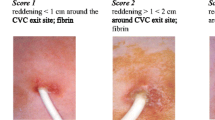Summary
Subcutaneously implanted infusion chambers represent a new method of central venous access. In 57 evaluable out of 70 patients, four different models of infusion chambers with an accumulative observation time of 57 years were implanted. In 72% of the patients, up to 12 cycles of polychemotherapy were administered. Parenteral nutrition and blood drawing were also performed. After 4,970 punctions of the system and 12.2 years of use 46 complications in 38 patients were observed, however, most were minor ones, such as temporary occlusions (12) and extravasations (14). Septum luxation (1), septum perforation (1), catheter fracture (1) and catheter migration (2) as well as 7 cases of septicemia or port-pocket-infection required explantation. Infusion chambers seem to be particularly suitable for intermittent and long-term chemotherapy and emergency bolus injections with a significant advantage (10 complications per one thousand days of use) compared to externally placed venous catheters. However, follow-up and care must be performed by a skilled team.
Zusammenfassung
Implantierbare subcutane Infusionskammern stellen eine attraktive Alternative zu konventionellen zentralvenösen Zugangssystemen dar. Bei 70 Patienten wurden 4 verschiedene Modelle implantiert. In 72% wurden bei 57 auswertbaren Patienten aufgrund einer Neoplasie bis zu 12 Cyclen einer Chemotherapie durchgeführt. Desweiteren erfolgten regelmäßige Blutentnahmen und teilweise parenterale Ernährung. Bei einer Gesamtimplantationszeit von 57 Jahren wurden 4970 Punktionen durchgeführt. Nach einer Gesamtbenutzungsdauer von 12,2 Jahren wurden 46 Komplikationen beobachtet, die in den meisten Fällen einfach therapiert werden konnten (temporärer Verschluß (12mal), Extravasion (14mal)). Neben Septumluxation (1mal) sowie Perforation (1mal) wurde ein Katheterbruch beobachtet. Ebenso machten 4 Implantattascheninfekte und 4 Katheter-bedingte Septicämien eine Explantation erforderlich. Infusionskammern stellten dennoch bei einer Komplikationsrate von 10 pro tausend Gebrauchstage für Arzt und Patient ein wenig störendes und zuverlässiges Zugangssystem mit deutlich besseren Ergebnissen dar, als nach Verwendung percutaner Katheter; Nachsorge und Betreuung bedürfen jedoch eines erfahrenen Teams.
Similar content being viewed by others
Literatur
Aiken DR, Minton JP (1984) The “pinch-off-sign” — a warning of independing problems with permanent subclavian catheters. Am J Surg 148:633–635
Blackshear PJ (1979) Implantable drug delivery systems. Sci Am 241:66–73
Bottnio J, McCredie KB, Groschel DH, Lawson M (1979) Longterm intravenous therapy with peripherally inserted silicone elastomer — central venous catheters in patients with malignant diseases. Cancer 52:P85–192
Broviac JW, Cole JJ, Scribner BH (1973) A silicone rubber arterial catheter for prolonged nutrition. Surg Gynecol Obstet 136:602–606
Brincker H, Saeter G (1986) Fifty-five patient years — Experience with a totally implanted system for intravenous chemotherapy. Cancer 57:1124–1129
Carrol C, Sarr MG, Stewart JR (1985) Percutaneous placement of two simple-lumen silastic catheters for long-term venous access. Cancer 55:2712–2714
Collin C, Constable FL, Johnston I (1975) Infusion trombophlebitis and injection with various canulae. Lancet 11:150–153
Dahl HD, Hengstmann JH, Bode U, Hansen H (1986) Klinische Anwendung eines vollstlindig implantierbaren Kathetersystems. Dtsch Med Wochenschr 11:88–92
Fischer W (1986) Zentralvenöse Punktion — Risiken und Komplikationen. Dtsch Arztebl 83:470–477
Gyves J, Ensminger W, Niederhuber J, Liepmann M, Cozzi E, Doan K, Dakkich S, Wheeler R (1982) Totally implanted system for intravenous chemotherapy in patients with cancer. Am J Med 73:841–845
Harwood KV, Aigner J (1984) Treatment of chemotherapy extravasion current status. Cancer Treat Rep 68:939–945
Hickmann RO, Buckner CD, Clift RA, Sanders JE, Stewart R, Thomas ED (1979) A modified right arterial catheter for access to the venous system in narrow transplant recipients. Surg Gynecol Obstet 148:871–875
Krog MPM, Ekbom A, Myström-Roander C, Rudberg CR, Simonsson B (1987) Central venous catheters in acute blood malignancies. Cancer 59:1358–1361
Kucuk O, Kwaan HC, Gunnar W, Vazquez RM (1985) Thromboembolic complications associated with L-asparaginase therapy. Cancer 55:702–706
Lokich JJ, Bothe A, Benotti P, Moore C (1985) Complications and management of implanted venous access catheters. J Clin Oncol 3:710–717
Lorenz M, Hottenrott C, Seufert RM, Kirkowa-Reimann M, Encke A (1986) Dauerhafter intravenöser oder intraarterieller Zugang mit einer subkutan liegenden implantierbaren Infusionskammer. Dtsch Med Wochenschr 111: 772–779
May GS (1986) Catheter fractures in implantable vascular access systems. Lancet 11: 692
Meurette J, Depadt G, Meynadier J (1985) Vascular access for intravenous chemotherapy: totally implanted systems. Eur J Surg Oncol 11:295–298
Peters G, Pulverer G, Locci R (1981) Bakteriell infizierte Venenkatheter, Dtsch Med Wochenschr 106:822–823
Pettigrew RA, Lang SDR, Haydock DA, Porry BR, Bremner DA, Hill GL (1985) Catheter-related sepsis in patients on intravenous nutrition — a prospective study of quantitative catheter cultures and guide wire changes for suspected sepsis. Br J Surg 72:52–55
Raaf JH (1985) Results from use of 826 vascular access devices in cancer patients. Cancer 55:1312–1321
Reed WP, Newmann KA, De Jongh C, Wade JC, Schimpff SC, Wiernick PH, McLaughlin JS (1983) Prolonged venous access for chemotherapy by means of the Hickman-catheter. Cancer 52: 185–192
Reed WP, Newmann KA, Applefield MM (1985) Drug extravasation as a complication of venous access port. Ann Intern Med 102:788–789
Reilly JJ, Steed DL, Ritter PS (1983) Indwelling venous access catheters in patients with acute leucaemia. Cancer 53:219–223
Sturm S, McDermed J, Korn A, Joseph C (1986) Improved methods for venous access — the port-a-cath, a totally implanted catheter system. J Clin Oncol 4:596–603
Torosian MH, Meranze S, McLean G, Muller JL (1986) Central venous access with occlusive superior central venous thrombosis. Ann Surg 203:30–33
Wade JC, Newmann KA, Schimpf SC (1981) Two methods for improved venous access in acute leukemia patients. JAMA 246:140–144
Wobbes T, Sloff MJH, Shiffer DT, Mulder NH, Postma AP (1983) Five year's experience in access surgery for polychemotherapy. Cancer 52:978–982
Author information
Authors and Affiliations
Rights and permissions
About this article
Cite this article
Lorenz, M., Hottenrott, C., Seufert, R.M. et al. Total implantierbarer dauerhafter zentralvenöser Zugang, Langzeiterfahrung mit subcutanen Infusionskammern. Langenbecks Arch Chiv 373, 302–309 (1988). https://doi.org/10.1007/BF01276546
Received:
Issue Date:
DOI: https://doi.org/10.1007/BF01276546




